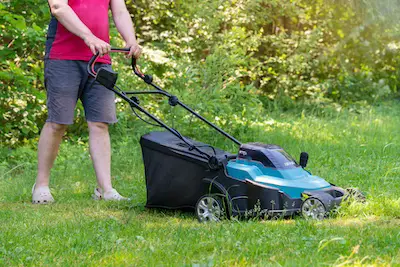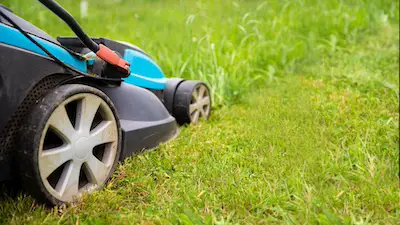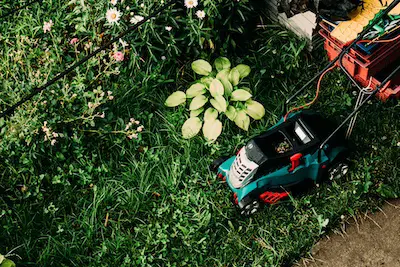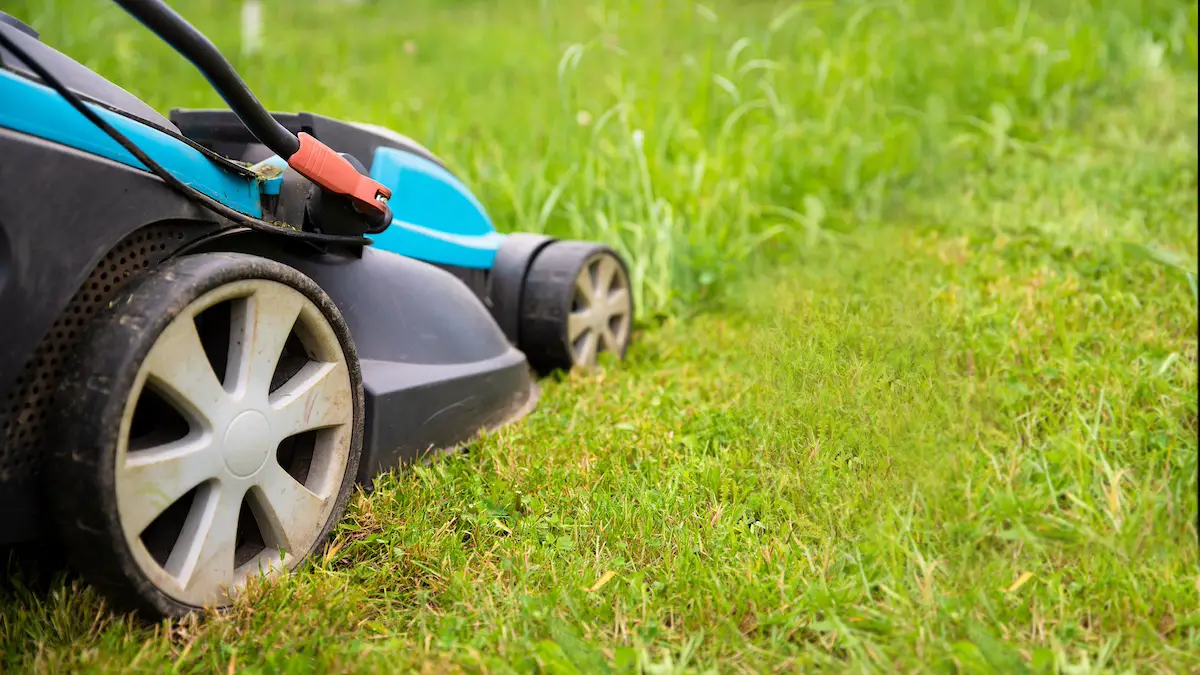Welcome to our exploration of battery technologies and the remarkable evolution that powers the cordless lawn mower today. At the heart of this advancement lies the lithium-ion battery, a vital component that has reshaped our approach to lawn maintenance.
In this post, we will aim to illuminate the various facets of battery-powered mowers, shedding light on why they have become an increasingly popular choice for homeowners.
Understanding Cordless Lawn Mower Battery Types
Stepping into the world of cordless lawn mowers, we uncover the secret behind their power and mobility: the battery. Unlike their corded counterparts, which rely on a continuous supply of electricity, cordless models offer the freedom to roam your yard without the tether of a power cord.
The heart of this innovation is primarily the lithium-ion battery, a technology shared with many of today’s smartphones, laptops, and even electric cars.
Cordless lawn mowers operate on lithium-ion batteries, which are known for their long life and ability to hold a charge over time. These batteries come in various voltages, significantly influencing the mower’s power and how long it can operate before needing a recharge.
Common voltages range from 20V to 80V, with higher voltages providing more power, akin to how a sports car offers more speed and acceleration than a family sedan.
The duration your mower can run on a single charge depends on the battery’s voltage and capacity, often measured in ampere-hours (Ah). A battery with a higher Ah rating can supply power for a longer period. Therefore, a 4Ah battery will keep your mower running longer than a 2Ah battery, but it will also take more time to charge.
Interestingly, the evolution of cordless lawn mowers mirrors advancements in battery technology. Early models were hampered by heavy, inefficient lead-acid batteries, but today’s lithium-ion batteries are lighter, charge faster, and last longer.
This leap in technology has made cordless lawn mowers more appealing, offering a combination of power, efficiency, and convenience that was hard to imagine just a few years ago.
Moreover, some cordless mowers feature a battery management system (BMS), which protects the battery against overcharging, overheating, and deep discharge. This system plays a critical role in extending the battery’s lifespan and ensuring the mower’s reliability.
The convenience of cordless lawn mowers extends beyond just their mobility. These mowers are generally quieter than their gasoline-powered equivalents, emit no exhaust fumes, and require less maintenance. There’s no need to store gasoline, change oil, or replace spark plugs. Simply charge the battery, and you’re ready to mow.
In essence, the technological heart of a cordless lawn mower—the lithium-ion battery—gives these modern marvels their power and freedom. As battery technology continues to evolve, we can expect cordless lawn mowers to become even more efficient, powerful, and convenient, making the task of maintaining a beautiful lawn easier than ever before.

Factors Affecting Battery Performance and Lifespan
Moving forward from the foundational elements that dictate the performance and efficiency of cordless lawn mowers, it’s imperative to delve into factors specifically influencing the variability of battery life in these devices. Battery life is a pivotal aspect, as it directly impacts the usability and convenience of cordless lawn mowers, making an understanding of its variabilities essential for users.
Condition of the Lawn
One of the primary factors contributing to fluctuations in battery life is the condition of the lawn being mowed. Thick, tall grass demands more power from the mower, thus consuming battery life more rapidly than when cutting shorter, thinner grass.
This increased power requirement is due to the additional resistance the blades encounter, requiring more energy to maintain the same cutting speed and efficiency.
Temperature
Temperature plays a crucial yet often overlooked role in the performance of lithium-ion batteries in cordless lawn mowers. Extremely cold temperatures can significantly reduce battery efficiency and capacity, leading to shorter mowing sessions.
Conversely, very high temperatures might lead to overheating issues, potentially damaging the battery and again curtailing battery life.
Age and Condition of Cordless Lawn Mower Battery
The age and condition of the battery also significantly impact its lifespan and performance. Over time, batteries naturally degrade, losing their ability to hold a charge as efficiently as when they were new. This degradation affects not only the runtime of the mower on a single charge but also the overall life span of the battery itself.
User Maintenance
User handling and maintenance practices are key to maximizing battery life. Proper storage, regular charging, and avoiding complete discharge can help maintain battery health. Batteries left discharged for extended periods or consistently drained completely before recharging may suffer from reduced capacity and a shortened overall lifespan.
Design of the Cordless Lawn Mower Mower
The variability in battery life is also partly due to the design and efficiency of the mower itself. Some models are engineered to maximize battery efficiency, incorporating features like adjustable power settings or eco-modes that match the power output to the task, preserving battery life for when it’s needed most.
Understanding these factors is crucial for anyone looking to get the most out of their cordless lawn mower.
By recognizing the conditions that affect battery life and adopting best practices for battery maintenance, users can ensure that their cordless lawn mowers continue to provide the convenience and performance that make them such a valuable addition to the garden care arsenal.

Maximizing Battery Life and Performance
Even after considering factors like the condition of your lawn and how temperature variations affect battery performance, there are still actionable strategies to extend the life of your cordless lawn mower’s battery.
These range from thoughtful handling and storage to optimizing the mower’s use. Let’s dive into some practical steps to ensure your mower’s battery remains robust and reliable.
Recalibrate Your Cordless Lawn Mower Battery
Firstly, it’s essential to recalibrate your battery periodically. Like all lithium-ion batteries, those in cordless lawn mowers benefit from a full discharge followed by a complete charge cycle. This process, recommended to be done at least once a season, helps in maintaining the accuracy of the battery’s power gauge, ensuring you get the maximum runtime during each mow.
Storing Your Battery Properly
Storing your battery properly cannot be overstressed. In the off-season, remove the battery from the mower and store it in a cool, dry place. Ideally, the storage temperature should be mild, avoiding the extremes of a hot garage or a freezing shed.
The ideal charge level for storage is around 40-50%. This level helps in preserving the battery’s health during periods not in use. Additionally, it’s worth checking in every few months to maintain this charge level if the battery self-discharges.
Cleaning Your Battery
Regular cleaning of the battery contacts can also play a significant role in extending its life. Dust, grass clippings, and moisture can accumulate on the battery and its connections, potentially causing corrosion or poor connections that strain the battery. Gently wipe the contacts with a dry cloth periodically to ensure a clean connection, thus enhancing efficiency.
Usage patterns hold a considerable influence over battery longevity. When mowing, tackle the tougher, higher grass in shorter sessions, allowing the battery (and mower) to cool down before continuing. This practice reduces the strain on the battery and prevents overheating, thus preserving its capacity over time.
Lastly, remember that all batteries have a lifespan, typically measured in charge cycles. Investing in a quality lawn mower from a reputable brand often means access to replaceable batteries. Once you notice a significant drop in the runtime, it may be more cost-effective to replace the battery rather than the entire mower.
In summary, extending the life of your cordless lawn mower’s battery hinges on regular recalibration, proper storage, cleanliness, mindful usage, and being open to eventual replacement. These steps not only contribute to the longevity of the battery but also the overall performance of your cordless lawn mower, ensuring it remains a convenient, efficient, and eco-friendly option for maintaining your lawn.
Comparing Cordless Mower Batteries with Traditional Fuel Options
Moving beyond the realm of cordless mowers, it’s pivotal to turn our focus towards gas-powered lawn mowers and juxtapose their operational longevity against their battery-powered counterparts.
Gas mowers, driven by internal combustion engines, have long been the go-to choice for extensive lawn care tasks, primarily owing to their extended running times and sheer power.
When evaluating which mower runs longer under a single “charge” – whether it’s a tank of gas or a fully charged battery – several nuances must be considered.
Gas mowers, inherently, do not face the limitations set by battery capacity. The endurance of a gas mower is directly linked to its fuel tank size and the efficiency of its engine.
Typically, a single fill can allow these mowers to operate for hours, enabling the completion of substantial mowing tasks without the need for refueling breaks. This aspect makes them especially favored for large properties or commercial lawn care operations where downtime equates to lost productivity.
However, it’s essential to acknowledge the flipside of gas mowers’ operational longevity. Their reliance on fossil fuels not only implicates environmental concerns but also subjects users to the fluctuating costs of gasoline.
Furthermore, the engine efficiency and fuel consumption can vary significantly among models and are influenced by the lawn’s condition and the mower’s age and maintenance.
Contrastingly, the runtime of battery-operated mowers is confined by the energy capacity of their batteries, typically quantified in ampere-hours (Ah).
While advancements in lithium-ion technology have notably enhanced their performance and runtime, they still necessitate periodic pauses for recharging. This can be a bottleneck for tackling larger lawns in one go.
It’s worth noting, however, that the gap in operational time between the two mower types narrows with each technological leap in battery development.
Environmental factors and usage habits also play a critical role in the performance dynamics of both gas and battery mowers. Optimal conditions and proper maintenance can extend the operational efficiency and lifespan of either type.
Yet, it’s the advancements in battery technology and the convenience of cordless operation that are steadily shifting the balance. As batteries become more potent and charging solutions more sophisticated, the allure of cordless mowers gains traction, not only for their environmental benefits but also for operational efficiency.
In conclusion, when deliberating on whether a battery or gas mower runs longer, the current verdict leans towards gas mowers for their uninterrupted runtimes on a single tank.
Nevertheless, the trajectory of technological innovations in battery-powered devices hints at a narrowing gap, with the potential for battery mowers to rival, if not surpass, the operational longevity of gas mowers in the foreseeable future.
The choice between these two types thus hinges not only on their runtime but also on considerations like environmental impact, maintenance, operational costs, and personal convenience preferences, marking a significant decision in the pursuit of lawn care excellence.

Is a Cordless Lawn Mower Right for You?
As we’ve examined the intricacies of battery technologies and their critical role in the effectiveness of cordless lawn mowers, it’s clear that the landscape of lawn maintenance is undergoing a significant transformation.
The fusion of convenience, eco-friendliness, and technological advancement positions cordless lawn mowers as not just tools, but as harbingers of a more sustainable and efficient approach to lawn care.
The continuous improvements in battery life and performance signal a bright future, potentially setting new standards for what we expect from our lawn maintenance equipment.

